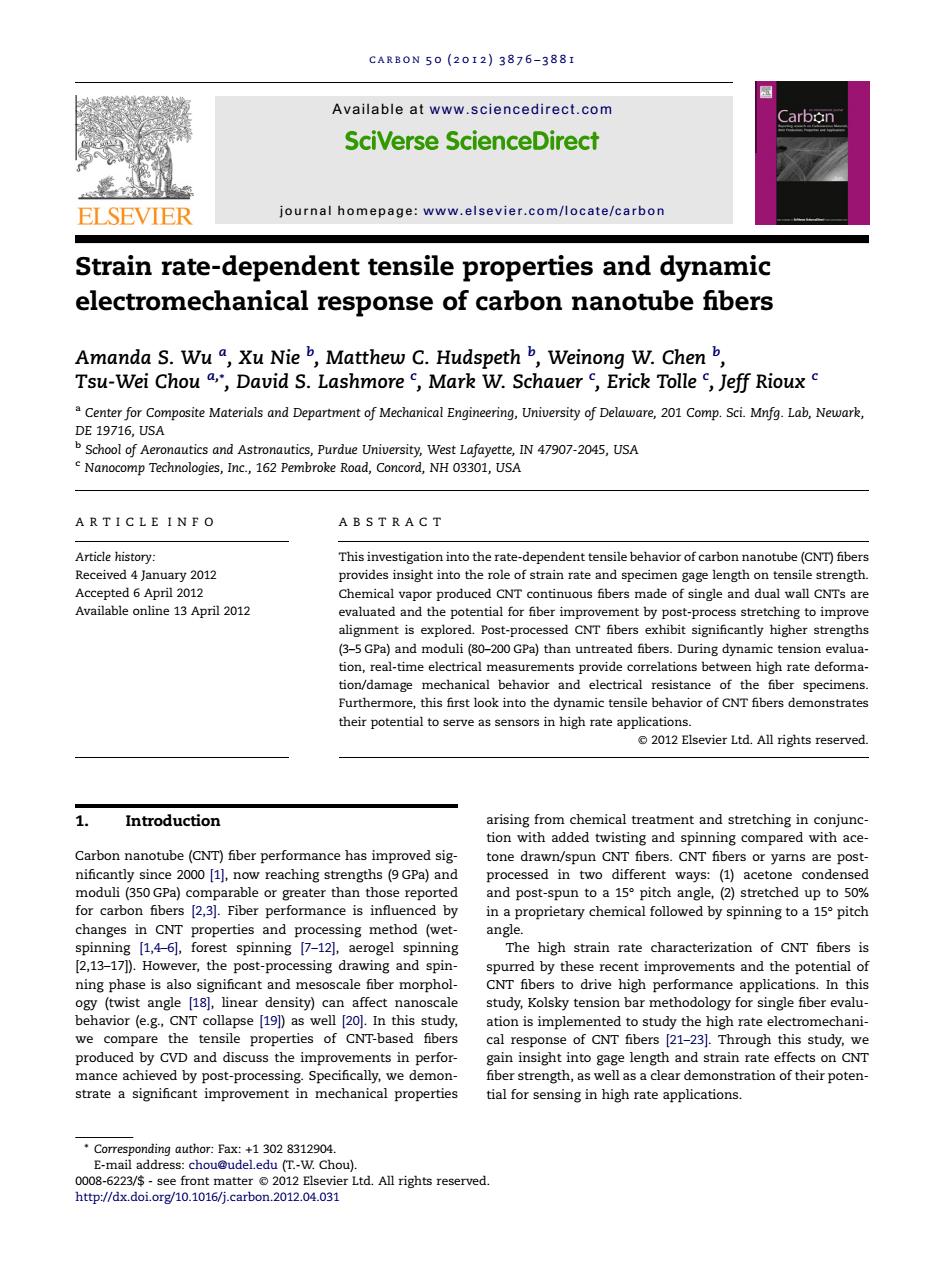正在加载图片...

CARB0N50(20I2)3876-388I Available at www.sciencedirect.com Carbon SciVerse ScienceDirect ELSEVIER journal homepage:www.elsevier.com/locate/carbon Strain rate-dependent tensile properties and dynamic electromechanical response of carbon nanotube fibers Amanda S.Wu,Xu Nie,Matthew C.Hudspeth,Weinong W.Chen Tsu-Wei Chou a.,David S.Lashmore Mark W.Schauer,Erick Tolle Jeff Rioux Center for Composite Materials and Department of Mechanical Engineering,University of Delaware,201 Comp.Sci.Mnfg.Lab,Newark, DE 19716,USA bSchool of Aeronautics and Astronautics,Purdue University,West Lafayette,IN 47907-2045,USA Nanocomp Technologies,Inc.,162 Pembroke Road,Concord,NH 03301,USA ARTICLE INFO ABSTRACT Article history: This investigation into the rate-dependent tensile behavior of carbon nanotube(CNT)fibers Received 4 January 2012 provides insight into the role of strain rate and specimen gage length on tensile strength. Accepted 6 April 2012 Chemical vapor produced CNT continuous fibers made of single and dual wall CNTs are Available online 13 April 2012 evaluated and the potential for fiber improvement by post-process stretching to improve alignment is explored.Post-processed CNT fibers exhibit significantly higher strengths (3-5 GPa)and moduli(80-200 GPa)than untreated fibers.During dynamic tension evalua- tion,real-time electrical measurements provide correlations between high rate deforma- tion/damage mechanical behavior and electrical resistance of the fiber specimens. Furthermore,this first look into the dynamic tensile behavior of CNT fibers demonstrates their potential to serve as sensors in high rate applications. 2012 Elsevier Ltd.All rights reserved. Introduction arising from chemical treatment and stretching in conjunc- tion with added twisting and spinning compared with ace- Carbon nanotube(CNT)fiber performance has improved sig- tone drawn/spun CNT fibers.CNT fibers or yarns are post- nificantly since 2000 [1],now reaching strengths(9 GPa)and processed in two different ways:(1)acetone condensed moduli (350 GPa)comparable or greater than those reported and post-spun to a 15 pitch angle,(2)stretched up to 50% for carbon fibers [2,3].Fiber performance is influenced by in a proprietary chemical followed by spinning to a 15 pitch changes in CNT properties and processing method (wet- angle. spinning [1,4-6],forest spinning [7-12],aerogel spinning The high strain rate characterization of CNT fibers is [2,13-17]).However,the post-processing drawing and spin- spurred by these recent improvements and the potential of ning phase is also significant and mesoscale fiber morphol- CNT fibers to drive high performance applications.In this ogy (twist angle [18],linear density)can affect nanoscale study,Kolsky tension bar methodology for single fiber evalu- behavior (e.g..CNT collapse [19))as well [20].In this study, ation is implemented to study the high rate electromechani- we compare the tensile properties of CNT-based fibers cal response of CNT fibers [21-23].Through this study,we produced by CVD and discuss the improvements in perfor- gain insight into gage length and strain rate effects on CNT mance achieved by post-processing.Specifically,we demon- fiber strength,as well as a clear demonstration of their poten- strate a signifcant improvement in mechanical properties tial for sensing in high rate applications. Corresponding author:Fax:+1302 8312904. E-mail address:chou@udel.edu (T.-W.Chou). 0008-6223/$-see front matter 2012 Elsevier Ltd.All rights reserved. http://dx.doi.org/10.1016/j.carbon.2012.04.031Strain rate-dependent tensile properties and dynamic electromechanical response of carbon nanotube fibers Amanda S. Wu a , Xu Nie b , Matthew C. Hudspeth b , Weinong W. Chen b , Tsu-Wei Chou a, * , David S. Lashmore c , Mark W. Schauer c , Erick Tolle c , Jeff Rioux c a Center for Composite Materials and Department of Mechanical Engineering, University of Delaware, 201 Comp. Sci. Mnfg. Lab, Newark, DE 19716, USA b School of Aeronautics and Astronautics, Purdue University, West Lafayette, IN 47907-2045, USA c Nanocomp Technologies, Inc., 162 Pembroke Road, Concord, NH 03301, USA ARTICLE INFO Article history: Received 4 January 2012 Accepted 6 April 2012 Available online 13 April 2012 ABSTRACT This investigation into the rate-dependent tensile behavior of carbon nanotube (CNT) fibers provides insight into the role of strain rate and specimen gage length on tensile strength. Chemical vapor produced CNT continuous fibers made of single and dual wall CNTs are evaluated and the potential for fiber improvement by post-process stretching to improve alignment is explored. Post-processed CNT fibers exhibit significantly higher strengths (3–5 GPa) and moduli (80–200 GPa) than untreated fibers. During dynamic tension evaluation, real-time electrical measurements provide correlations between high rate deformation/damage mechanical behavior and electrical resistance of the fiber specimens. Furthermore, this first look into the dynamic tensile behavior of CNT fibers demonstrates their potential to serve as sensors in high rate applications. 2012 Elsevier Ltd. All rights reserved. 1. Introduction Carbon nanotube (CNT) fiber performance has improved significantly since 2000 [1], now reaching strengths (9 GPa) and moduli (350 GPa) comparable or greater than those reported for carbon fibers [2,3]. Fiber performance is influenced by changes in CNT properties and processing method (wetspinning [1,4–6], forest spinning [7–12], aerogel spinning [2,13–17]). However, the post-processing drawing and spinning phase is also significant and mesoscale fiber morphology (twist angle [18], linear density) can affect nanoscale behavior (e.g., CNT collapse [19]) as well [20]. In this study, we compare the tensile properties of CNT-based fibers produced by CVD and discuss the improvements in performance achieved by post-processing. Specifically, we demonstrate a significant improvement in mechanical properties arising from chemical treatment and stretching in conjunction with added twisting and spinning compared with acetone drawn/spun CNT fibers. CNT fibers or yarns are postprocessed in two different ways: (1) acetone condensed and post-spun to a 15 pitch angle, (2) stretched up to 50% in a proprietary chemical followed by spinning to a 15 pitch angle. The high strain rate characterization of CNT fibers is spurred by these recent improvements and the potential of CNT fibers to drive high performance applications. In this study, Kolsky tension bar methodology for single fiber evaluation is implemented to study the high rate electromechanical response of CNT fibers [21–23]. Through this study, we gain insight into gage length and strain rate effects on CNT fiber strength, as well as a clear demonstration of their potential for sensing in high rate applications. 0008-6223/$ - see front matter 2012 Elsevier Ltd. All rights reserved. http://dx.doi.org/10.1016/j.carbon.2012.04.031 * Corresponding author: Fax: +1 302 8312904. E-mail address: chou@udel.edu (T.-W. Chou). CARBON 50 (2012) 3876 – 3881 Available at www.sciencedirect.com journal homepage: www.elsevier.com/locate/carbon����